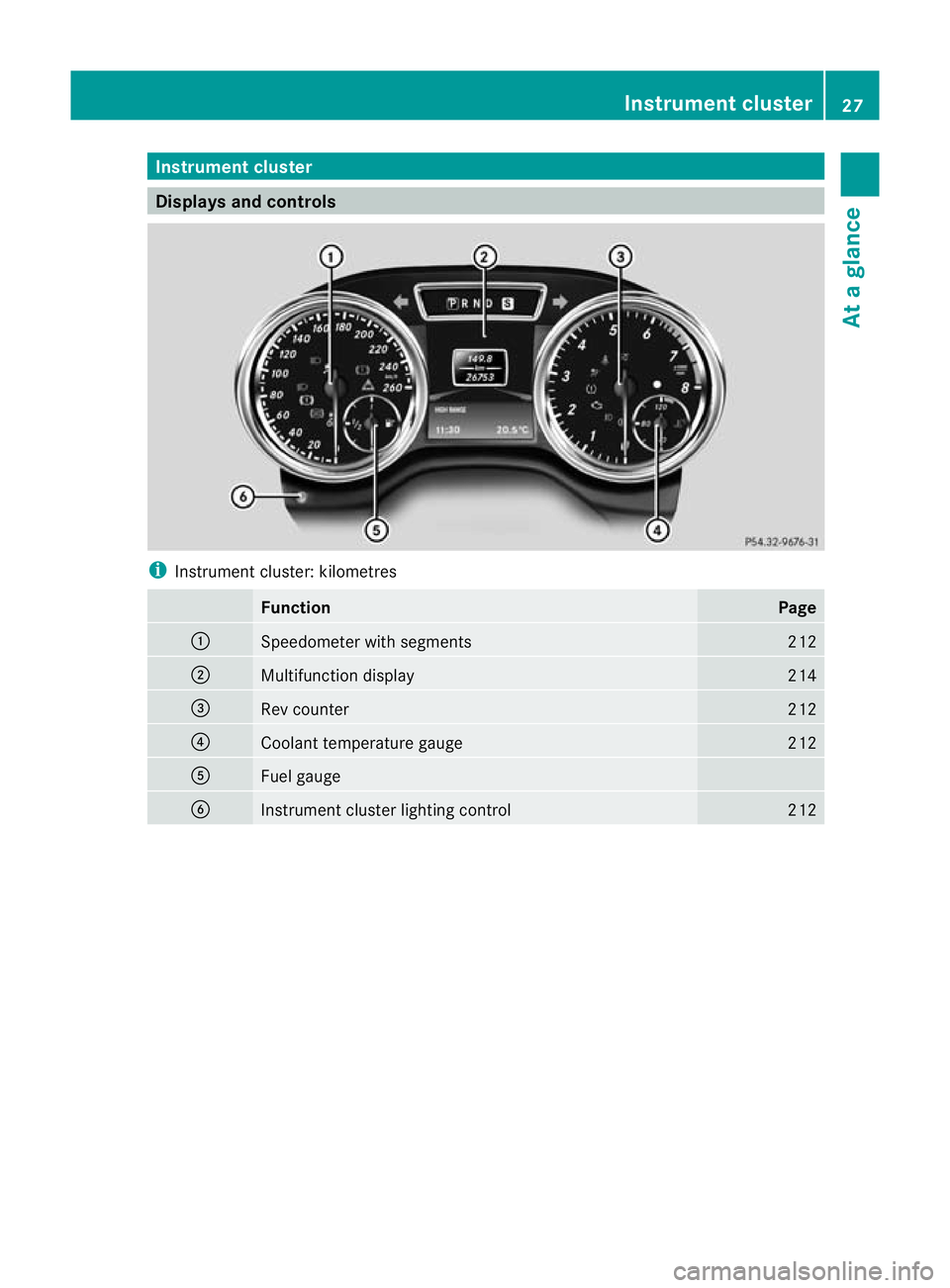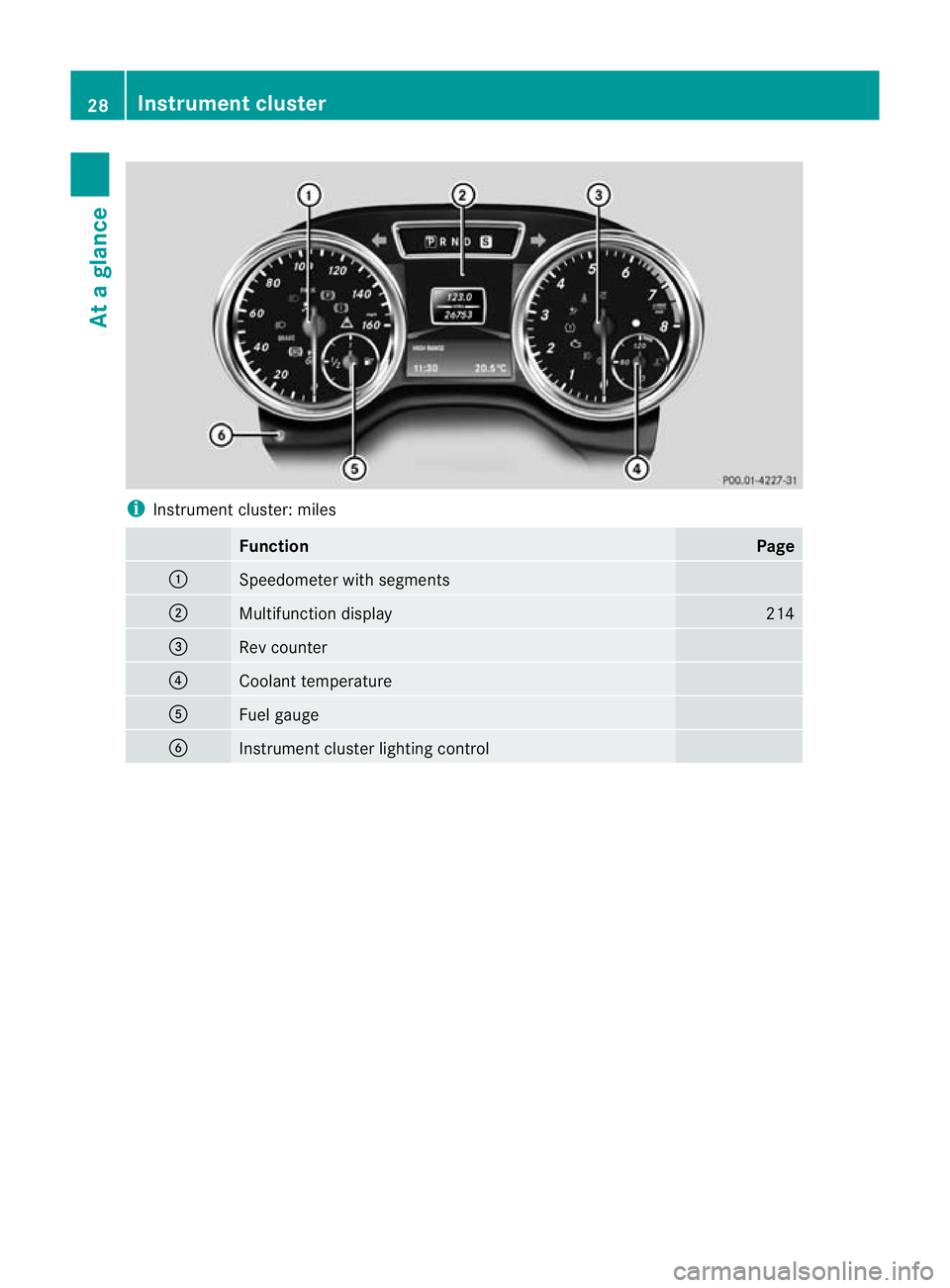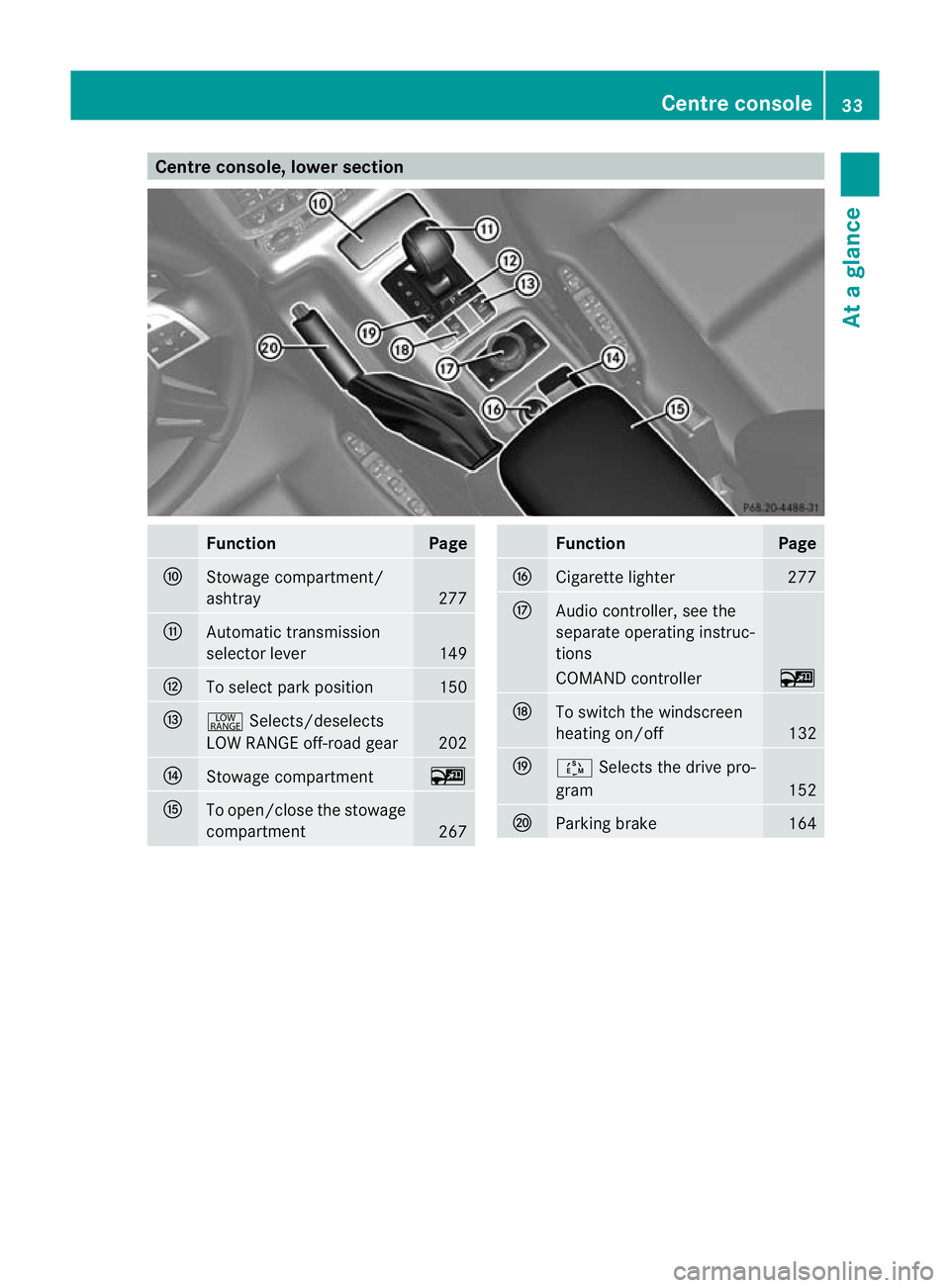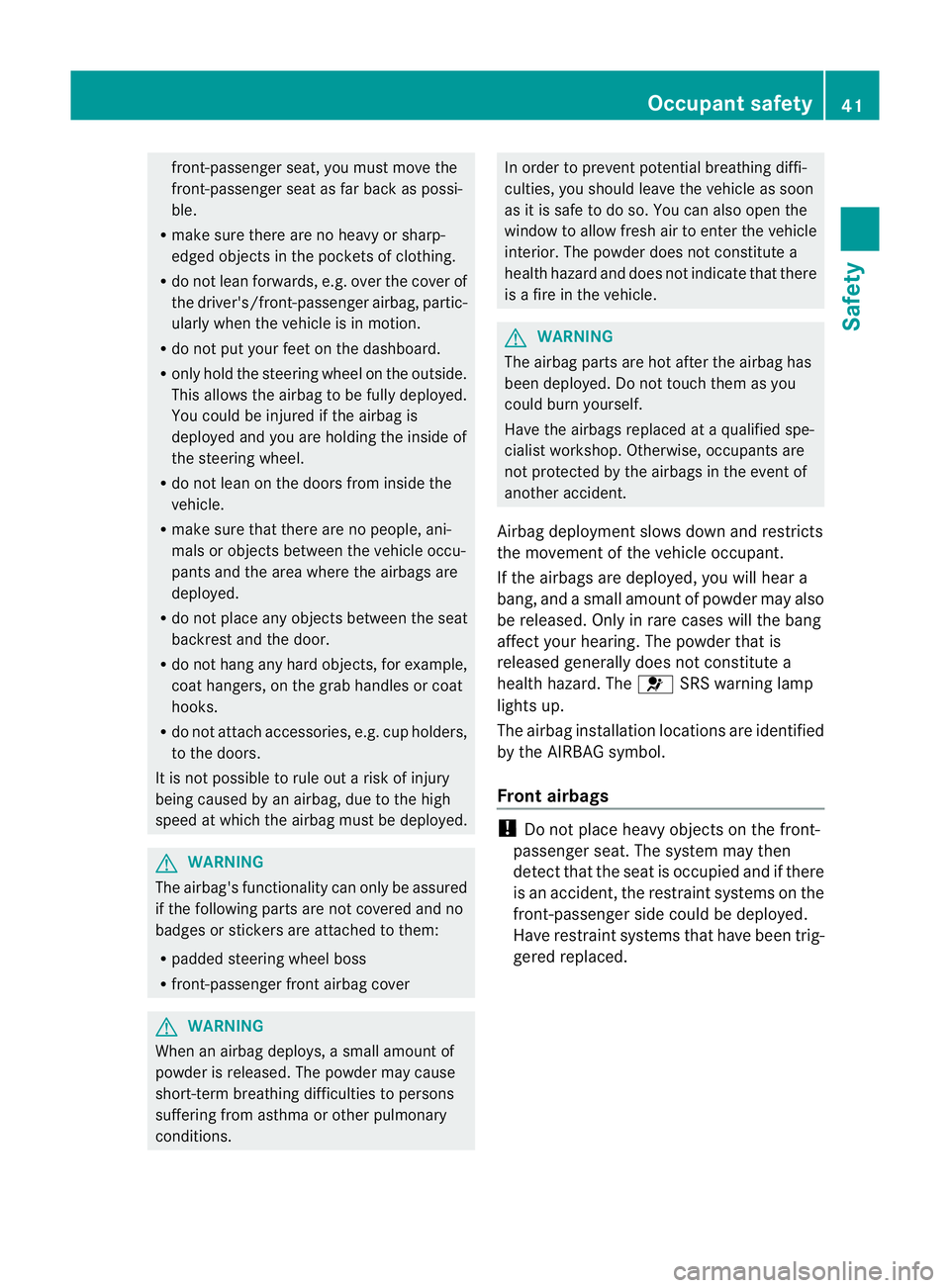2012 MERCEDES-BENZ G-CLASS SUV light
[x] Cancel search: lightPage 19 of 357

SRS (Supplemental Restraint Sys-
tem)
Display message ............................ 233
Introduction ..................................... 39
Warning lamp ................................. 259
Warning lamp (function) ................... 39
Starting the engine
Important safety notes ..................144
Steering (display message) ..............250
Steering wheel Adjusting (electrically). ....................97
Buttons (on-board computer) ......... 213
Gearshift paddles ........................... 153
Important safety notes ....................97
Steering wheel heating ....................97
Storing settings (memory function) 102
Steering wheel gearshift paddles ....153
Steering wheel heating Malfunction indicator lamp ..............98
Stopwatch (RACETIMER) ................... 226
Stowage areas ................................... 267
Stowage compartment Map pockets .................................. 268
Stowage compartments
Armrest (underneath) ....................268
Cuph older..................................... 275
Glove compartment .......................267
Important safety information .........267
Summer tyres .................................... 323
Sun visor ............................................ 276
Supplemental Restraint System see SRS (Supplemental Restraint
System)
Supplement Restraint System
see SRS (Supplemental Restraint
System)
Surround lighting (on-board com-
puter) ................................................. .222
Suspension tuning SETUP (on-board computer) ..........226
Switching off the alarm (ATA) ............64 T
Tailgate Display message ............................ 249
Opening dimensions ......................348
Tailgate (Cabriolet)
Opening/closing .............................. 76
opening the cover ..........................304
Tail lamps
Display message ............................ 236
see Lights
Technical data
Capacities ...................................... 341
Information .................................... 338
Trailer loads ................................... 350
Tyres .............................................. 333
Tyres/wheels ................................. 333
Vehicle data ................................... 348
Wheels ........................................... 333
Telephone
Accepting acall............................. 219
Display message ............................ 251
Menu (on-board computer) ............218
Number from the phone book ....... .219
Redialling ....................................... 220
Rejecting/ending acall................. 219
Telephone compartment ..................268
Temperature Coolant .......................................... 212
Coolant (on-board computer) ......... 225
Engine oil (on-board computer) ...... 225
Outside temperature ..................... .212
Setting (climate control) ................131
TEMPOMAT
Function/notes ............................. 173
Theft-deterrent system
ATA (Anti-Theft Alarm system) .........64
Immobiliser ...................................... 64
Tilt/sliding sunroof
see Sliding sunroof
Time
see Separate Owner' smanual
Timing (RACETIMER) .........................226
Tonneau cover ..................................... 85
Top Tether ............................................ 52
Total distance recorder ....................215
Tow-away protection ..........................6516
Index
Page 20 of 357

Towing
Important safety notes ..................315
In the event of malfunctions ..........317
Towing atrailer
Activ eBlind Spot Assist .................196
Axle load, permissible ....................350
Trailer tow hitch ............................. 350
Towing away
With both axles on the ground .......317
Towing eye
Front .............................................. 316
Rea r............................................... 316
Tow-starting
Important safety notes ..................315
Trailer
7-pin connector ............................. 208
Power supply ................................. 208
Trailer coupling (cleaning instruc-
tions) .................................................. 299
Trailer loads Technical data ............................... 350
Trailer towing
Blind Spot Assist ............................ 192
Driving tips .................................... 206
ESP ®
................................................ 63
Lights displa ymessage .................. 234
Mounting dimensions ....................350
Parktroni c...................................... 199
Shift range ..................................... 152
Trailer loads ................................... 350
Transfer case
General notes ................................ 201
Shifting .......................................... 202
Shifting (general notes) .................. 202
Shifting (important safety notes) ...202
Shifting to neutra l.......................... 203
Shift range ..................................... 201
Switching off the off-road gear
ratio ............................................... 203
Switching on the off-road gear
ratio ............................................... 202
Transmission
see Automatic transmission
Transmission positions ....................151
Transport (vehicle) ............................317
Travelling uphill Brow of hill ..................................... 173 Trip computer (on-board computer)
215
Trip meter Calling up ....................................... 215
Resetting (on-board computer) ......216
Turn signals
Changing bulbs (front) ...................117
Switching on/off ........................... 108
Two-way radio
Frequencies ................................... 339
Installatio n..................................... 339
Transmission output (maximum) .... 339
Type identification plate
see Vehicle identification plate
Tyre pressure
Calling up (on-board computer) .....327
Checking manually ........................327
Display message ............................ 245
Recommended ............................... 325
Table (single tyres )......................... 326
Tyre pressure monitor
Checking the tyre pressure elec-
tronically ........................................ 328
Function/notes ............................. 327
Restarting ...................................... 328
Warning lamp ................................. 263
Warning message .......................... 328
Tyres
Changing awheel .......................... 329
Checking ........................................ 323
Direction of rotatio n...................... 330
Display message ............................ 245
Grip ................................................ 166
Important safety notes ..................322
Replacing ....................................... 329
Service life ..................................... 323
Storing ........................................... 330
Technical data ............................... 333
Tyr esize (data) .............................. 333
Tyr etread ...................................... 323
see Flat tyre U
Unladen weight ................................. 348
Unlocking Emergency unlocking .......................74
From inside the vehicle (central
unlocking button) ............................. 73 Index
17
Page 30 of 357

Instrumen
tcluster Displays and controls
i
Instrument cluster: kilometres Function Page
:
Speedometer with segments 212
;
Multifunction display 214
=
Rev counter 212
?
Coolant temperature gauge 212
A
Fuel gauge
B
Instrument cluster lighting control 212Instrument cluster
27At a glance
Page 31 of 357

i
Instrument cluster: miles Function Page
:
Speedometer with segments
;
Multifunction display 214
=
Rev counter
?
Coolant temperature
A
Fuel gauge
B
Instrument cluster lighting control28
Instrument clusterAt a glance
Page 36 of 357

Centre console, lower section
Function Page
F
Stowage compartment/
ashtray
277
G
Automatic transmission
selecto
rlever 149
H
To select park position 150
I
+
Selects/deselects
LOW RANGE off-road gear 202
J
Stowage compartment ~
K
To open/close the stowage
compartment
267 Function Page
L
Cigarette lighter 277
M
Audio controller, see the
separate operating instruc-
tions
COMAND controller ~
N
To switch the windscreen
heating on/off
132
O
Ú
Selects the drive pro-
gram 152
P
Parking brake 164Centre console
33At a glance
Page 37 of 357

Overhea
dcontrol panel Function Page
:
p
Switches the left-
hand reading lamp on/off 110
;
c
Switches the front
interio rlighting on 112
=
u
Switches the rear
interior lighting on/off 112
?
|
Switches the front
interior lighting/automatic
interior lighting control off 111
A
p
Switches the right-
hand reading lamp on/off 110 Function Page
B
¡
Opens/closes the
sliding sunroof 79
C
ë
Deactivates tow-
away protection 65
D
Rear-view mirror 99
E
Buttons for the garage door
opener 282
F
ê
Deactivates the inte-
rior motion sensor 6534
Overhead control panelAt a glance
Page 42 of 357

SRS (Supplemental Restraint System)
Introduction SRS reduces the risk of occupants coming
into contact with the vehicle's interior in the
event of an accident. It can also reduce the
forces to which occupants are subjected dur-
ing an accident.
SRS consists of:
R the 6 SRS warning lamp
R airbags
R airbag control unit (with crash sensors)
R belt tensioners
R belt force limiters
SRS warning lamp G
WARNING
If SRS is malfunctioning, individual systems
may be triggered unintentionally or might not
be triggered in the event of an accident with
a high rate of vehicle deceleration.
A malfunction has occurred if:
R the 6 SRS warning lamp does not light
up when the ignition is switched on.
R the engine is running and the 6SRS
warning lamp does not go out after a few
seconds.
R the engine is running and the 6SRS
warning lamp lights up again.
In this case, have SRS checked immediately
at a qualified specialist workshop.
SRS functions are checked regularly when
you switch on the ignition and when the
engine is running. Therefore, malfunctions
can be detected in good time.
The 6 SRS warning lamp in the instrument
cluster lights up when the ignition is switched
on. It goes out no later than a few seconds
after the engine is started. Triggering of belt tensioners, belt force
limiters and airbags During the first stage of a collision, the airbag
control unit evaluates important physical
data relating to vehicle deceleration or accel-
eration, such as:
R
duration
R direction
R magnitude
Based on the evaluation of this data, the air-
bag control unit pre-emptively triggers the
belt tensioners in the first stage.
i The belt tensioners can only be triggered
if the seat belt tongues are correctly
engaged in the seat belt buckles.
If there is an even higher rate of vehicle decel-
eration or acceleration in a longitudinal direc-
tion, the front airbags are also deployed.
Your vehicle is equipped with adual-stage
driver's airbag and a single-stage front-
passenger fron tairbag. The airbag control
unit evaluates vehicle deceleration or accel-
eration in the event of a collision. In the first
deploymen tstage, the driver's airbag is filled
with enough propellant gas to reduce the risk
of injuries .The front airbag is fully deployed
if a second deployment threshold is exceeded
within a few milliseconds. The front-
passenger front airbag is filled with the max-
imum amount of propellant gas in one stage
at the moment of impact.
The belt tensioner and airbag triggering
thresholds are variable and are adapted to the
rate of deceleration or acceleration of the
vehicle. This process is pre-emptive in nature.
The triggering process must take place in
good time at the start of the collision.
i Airbags are not deployed in all types of
accidents. Also, not all airbags are
deployed together in an accident. The dif-
ferent airbag systems work independently
of each other. Occupant safety
39Safety Z
Page 44 of 357

front-passenger seat, you must move the
front-passenger sea tas far back as possi-
ble.
R make sure there are no heavy or sharp-
edged objects in the pockets of clothing.
R do not lean forwards, e.g. over the cover of
the driver's/front-passenger airbag, partic-
ularly when the vehicle is in motion.
R do not put your feet on the dashboard.
R only hold the steering wheel on the outside.
This allows the airbag to be fully deployed.
You could be injured if the airbag is
deployed and you are holding the inside of
the steering wheel.
R do not lean on the doors from inside the
vehicle.
R make sure that there are no people, ani-
mals or objects between the vehicle occu-
pants and the area where the airbags are
deployed.
R do not place any objects between the seat
backrest and the door.
R do not hang any hard objects, for example,
coat hangers, on the grab handles or coat
hooks.
R do not attach accessories, e.g. cup holders,
to the doors.
It is not possible to rule out a risk of injury
being caused by an airbag, due to the high
speed at which the airbag must be deployed. G
WARNING
The airbag's functionality can only be assured
if the following parts are not covered and no
badges or stickers are attached to them:
R padded steering wheel boss
R front-passenger front airbag cover G
WARNING
When an airbag deploys, a small amount of
powder is released.T he powder may cause
short-term breathing difficulties to persons
suffering from asthma or other pulmonary
conditions. In order to prevent potential breathing diffi-
culties, you should leave the vehicle as soon
as it is safe to do so. You can also open the
window to allow fresh air to enter the vehicle
interior. The powder does not constitute a
health hazard and does not indicate that there
is a fire in the vehicle. G
WARNING
The airbag parts are hot after the airbag has
been deployed. Do not touch them as you
could burn yourself.
Have the airbags replaced at a qualified spe-
cialist workshop. Otherwise, occupants are
not protected by the airbags in the event of
another accident.
Airbag deployment slows down and restricts
the movement of the vehicle occupant.
If the airbags are deployed, you will hear a
bang, and a small amount of powder may also
be released. Only in rare cases will the bang
affect your hearing. The powder that is
released generally does not constitute a
health hazard. The 6SRS warning lamp
lights up.
The airbag installation locations are identified
by the AIRBAG symbol.
Front airbags !
Do not place heavy objects on the front-
passenger seat. The system may then
detect that the seat is occupied and if there
is an accident, the restraint systems on the
front-passenger side could be deployed.
Have restraint systems that have been trig-
gered replaced. Occupant safety
41Safety Z